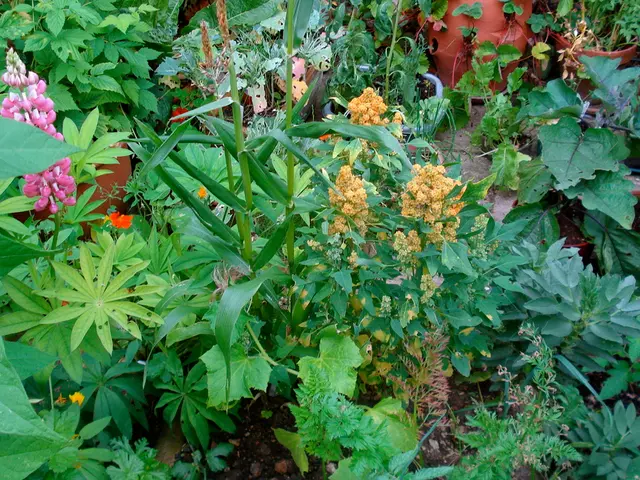Creating Vinegar: A Step-by-Step Guide
Confidently Create Your Own Vinegar at Home: A Step-by-Step Guide to Crafting Apple Cider, Mead, and Carrot Juice Vinegar
Vinegar, a staple in both cooking and cleaning, has been part of human history for thousands of years. No longer is it limited to white vinegar, cider vinegar, and balsamic vinegar; with a little DIY fermentation, you can craft an array of unique vinegars in the comfort of your home. This guide will walk you through creating vinegar from apple cider, mead, and even carrot juice!
The History and Science of Vinegar
Originating as the world's first condiment, vinegar has been utilized for preserving, sanitizing, flavoring, and even medical purposes throughout history. Its name comes from "sour wine," denoting wine that has undergone fermentation and converted into acidic vinegar. Acetic acid bacteria, present in the air, facilitate this transformation when exposed to alcohol. As every civilization has created diverse alcoholic beverages according to their region's ingredients, vinegar has been present in various forms across the globe and throughout time.
Making Vinegar at Home
Ingredients Required - Alcohol and Acetic Acid Bacteria
To craft vinegar at home, you'll need alcohol, preferably with an alcohol concentration between 5 and 9%, and acetic acid bacteria. You can use a multitude of drinks, including hard cider, wine, beer, mead, perry, fruit wine, or sake. Ensure your alcohol of choice does not contain sulfites or additives, as these could inhibit fermentation.
To foster the growth of acetic acid bacteria, you can either allow wild bacteria to colonize your alcohol over time, or seed it with a mother of vinegar (a liquid teeming with acetic acid bacteria). The mother of vinegar works best when you add about 20% of it to the volume of your desired alcohol.
The Process of Making Vinegar
Preparation - Making Alcohol
In order to craft vinegar, you'll first need to prepare a liquid containing alcohol. If your starting liquid does not naturally contain alcohol, you have two options:
- Ferment the liquid into alcohol using yeast (alcoholic fermentation)
- Add alcohol to the liquid (no fermentation)
Fermentation of Alcohol into Vinegar
The fermentation of alcohol into vinegar unfolds as follows: Acetic acid bacteria convert the alcohol into acetic acid (vinegar) through a process known as acetic fermentation. This process requires oxygen, so it's advantageous to stir the liquid daily or use an aquarium air pump to increase oxygenation levels and speed up fermentation.
Once your vinegar has properly fermented, it can then be aged for added complexity and refinement. Young vinegar is often quite harsh on the palate, but with time, its flavors develop and mellow.
Variety Is the Spice of Life: Try These Vinegar Recipes
Apple Cider Vinegar
To create apple cider vinegar, combine 1.5 liters of organic apple cider, 250 milliliters of filtered water, and 350 milliliters of unpasteurized vinegar or a vinegar mother. Mix well, cover the container loosely with a cotton cloth, and secure with a rubber band. Allow the mixture to ferment at room temperature for three months, tasting periodically. If you're satisfied with the acidity, bottle up the vinegar and enjoy!
Mead Vinegar
For a more unique twist, try making mead vinegar. If you haven't already made mead (honey wine), ferment honey and water with yeast first, then expose the mead to air and introduce a vinegar mother or raw vinegar. Ferment until it tastes like vinegar.
Carrot Juice Vinegar
To craft carrot juice vinegar, juice fresh carrots, add sugar (if needed), ferment with yeast to produce alcohol, and then add a vinegar mother or expose the liquid to air to convert the alcohol into vinegar.
Top Tips for Making Exceptional Vinegar
- Aerate During Fermentation - Increase the oxygen levels of the liquid by using an air pump or simply stirring daily. This speeds up the fermentation process.
- Aging to Develop Flavors - Bottling your vinegar and aging it in a cool, dark place allows new flavors to develop. Take care to ensure that the bottles are airtight, protected from direct sunlight, and completely sealed.
- Flavoring Before Fermentation - Add strong alcohol, such as vodka, brandy, or ethanol, to various juices, such as celery, carrot, or pumpkin, before fermenting. You can also add oak chips, herbs, or dried fruit to your fermenting vinegar.
- Flavoring the Vinegar After Fermentation - During the bottling process, you can add ingredients like oak chips, rosemary, hot peppers, or other desired flavors to your vinegar as it ages. This process creates "fire vinegar."
- "Fire Vinegar" - Infuse a mixture of garlic, onions, ginger, turmeric, and other plants with vinegar for an ironclad tonic.
Frequently Asked Questions
Do I need a mother of vinegar to make vinegar?
While a mother of vinegar does speed up the process, it is not absolutely necessary for vinegar production. You can also use a kombucha scoby, unpasteurized vinegar, or rely on wild yeast.
Can I make vinegar with strong alcohol?
Yes, but it must be diluted first to ensure a suitable concentration for fermentation.
Can I make vinegar with fruit or vegetable juice?
Although some recipes claim success with fruit peels and scraps, there is a higher failure rate, and mold growth is more likely. It's best to start with alcohol to maximize the chances of success.
Sources:1. Apple Cider Vinegar Recipe: Step by Step Guide to Making Your Own APV at Home2. Home Made Cider Vinegar Recipe3. Make Your Own Apple Cider Vinegar: A Step-by-Step Guide4. Homemade Vinegar: The Complete Guide5. How to Make Vinegar: A DIY Tutorial
Vinegar, a versatile substance historically used for cooking, cleaning, and medicinal purposes, has diversified beyond traditional flavors with at-home fermentation. Beginning with a base of alcohol and acetic acid bacteria, one can explore health-and-wellness and lifestyle choices by crafting unique vinegars such as apple cider, mead, or carrot juice vinegar.
Home-made vinegar is a fascinating mix of science and creativity, evolving through the transformation of alcohol into acetic acid through acetic fermentation. The process requires oxygenation, which encourages acetic acid bacteria to thrive, and typically takes several months to complete.
By following the specific recipes for apple cider, mead, or carrot juice vinegar, anyone can unleash their inner alchemist, experimenting with an assortment of food-and-drink combinations and flavorings to tailor vinegar to their personal taste.








